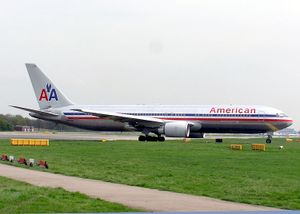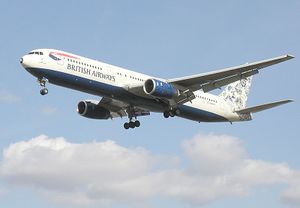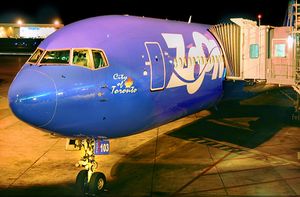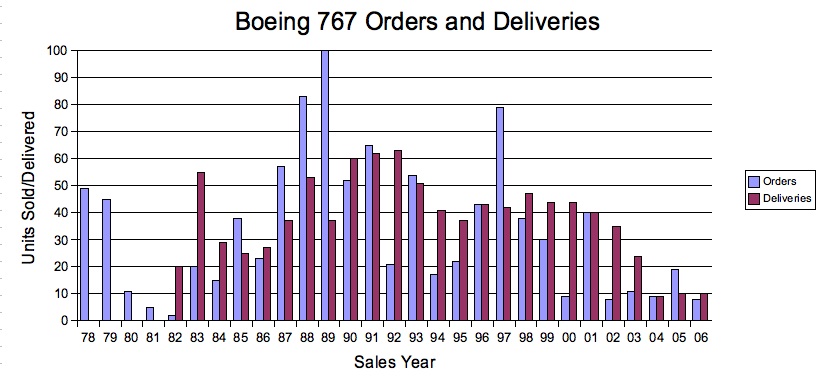PlaneSpottingWorld welcomes all new members! Please gives your ideas at the Terminal.
Boeing 767
| Boeing 767 | |
|---|---|
| Air Canada Boeing 767-300ER | |
| Type | Airliner |
| Manufacturer | Boeing Commercial Airplanes |
| Maiden flight | 1981-09-26 |
| Introduced | 1982-09-08 with United Airlines |
| Status | Active |
| Primary users | Delta Air Lines (102) American Airlines (74) All Nippon Airways (53) Air Canada (45) |
| Produced | 1982 - Present |
| Number built | 947 |
| Unit cost | 767-200ER: US$118.0-128.0 million 767-300ER: US$133.0-149.0 million 767-300F: US$143.0-155.0 million 767-400ER: US$146.0-160.5 million |
| Variants | Boeing KC-767 E-10 MC2A |
The Boeing 767 is a commercial passenger aircraft manufactured by Boeing's Commercial Airplane division.
Contents
Description
The Boeing 767, a widebody jet was introduced at around the same time as the 757 (its narrowbody sister), in the early 1980s. With the 707 aging, Boeing decided to offer a midsize plane to fit in between the 727/737/757 and the 747. The aircraft has a fuselage width of 15 ft 6 in (472,44 cm) that splits the difference between the aircraft in half. It is offered in a twin aisle configuration of 2+3+2 in economy with the most common business configuration of 2+2+2. It is possible in some charter configurations to squeeze an extra seat for a 2+4+2 configuration, however the seats are very narrow and this is not common.
The 767 has a seat-to-aisle ratio in economy class of 3.5 seats per aisle, making for quicker food service and quicker exit of the plane than many other jetliners, which typically have between four and six seats per aisle in economy class. The flight decks of the Boeing 757 and 767 are very similar and as a result, after a short conversion course, pilots rated in the 757 are also qualified to fly the 767 and vice versa.
Newer 767-200s and 767-300s, as well as all 767-400ERs, feature a 777-style cabin interior, also known as the "Boeing Signature Interior". The 767-400ER also features larger windows exactly like those found on the 777. All new 767s currently built feature the Signature Interior, and is also available as a retrofit for older 767s.
In addition to the Boeing Signature Interior retrofit option, a simpler mod known as the "Boeing 767 Enhanced Interior" is available. This retrofit borrows styling elements from the Boeing Signature Interior, however, the outer section overhead bins are traditional-style shelf bins rather than the 777-style pivot bins.
The 767 sold very well in the late 1980s and early 1990s, although sales have slowed considerably in recent years. At the end of 2006, the Boeing 767 had 975 orders with 947 of those delivered. In February 2007, United Parcel Service prolonged the lifespan of the 767 with an order for 27 767-300F freighters to be delivered between 2009 and 2012.
Variants
There are three variants of the 767 and launched on three separate occasions. The -200 variant was launched in 1978 with introduction into service in 1981. The -300 was launched in 1983 and entered service in 1986. The last variant, the -400 was launched in 1998 and entered service in 2000. Although there are a total of three variants, several versions have been produced.
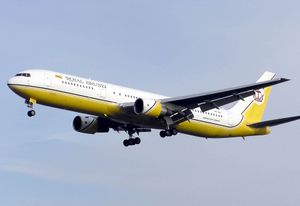
767-200
The first model of the 767, was launched in 1978 and entered service with United Airlines in 1982. This model is used mainly for continental routes such as New York to Los Angeles. The 767-200 typically is outfited with 181 seats in a 3-class layout or 224 in a 2-class layout. All -200 models have a capacity limit of 255 due to exit-door limitations.
767-200ER
An extended-range variant first delivered to El Al in 1984. It became the first 767 to complete a nonstop transatlantic journey, and broke the flying distance record for twinjet airliners several times. Although the 767-200ER has no direct replacement, it is expected to be replaced indirectly in Boeing's lineup by the 787-8.
As of December 2006 total orders for -200/200ER stand at 249 of which 128 are for the -200 (all delivered), and 121 for the -200ER (118 delivered).
767-300
A lengthened 767 ordered by Japan Airlines in 1983. It first flew on January 14, 1986, and was delivered to JAL on September 25. The 767-300 is expected to be replaced by the 787-3 in Boeing's lineup.
767-300ER
An extended-range version of the -300. It first flew in 1986 and received its first commercial orders when American Airlines purchased several in 1987. The aircraft entered service with AA in 1988. In 1995, EVA Air used a 767-300ER to inaugurate the first transpacific 767 service. The -300ER has a minimum takeoff run of around 6,000 ft (1,825 m), and a maximum of 7,900 ft (2,400 m). The 767-300ER is expected to be replaced by the 787-8 in Boeing's lineup.
767-300F
An air freight version of the 767-300ER, first ordered by United Parcel Service in 1993 and delivered in 1995.
Due to its unique fuselage width of 15 ft 6 in, it is unable to carry ordinary Unit Load Devices, and instead has to use specially designed air freight containers and pallets. This model has three doors on the maindeck plus 2 on the lower deck. Of the 3 doors on top, two are at the front, and one is at the rear right side. The two lower doors comprise of one at the right front and one at the rear left.
As of December 2006, total orders for the -300/300ER/300F stand at 688, of which 104 are for the -300 (104 delivered), 534 are for the -300ER (514 delivered), and 50 are for the -300F (46 delivered). Total deliveries for the -300 variants are 664.
767-400ER
This final extended variant was launched in 1997 on an order for Delta Air Lines and Continental Airlines to replace their aging Lockheed L-1011 and McDonnell Douglas DC-10 fleets. It was again stretched 21.1 ft for a total of 201.4 ft. It also saw a wingspan increase of 14.3 feet over the previous two models and is the only 767 model to also feature "raked" wingtips, which increase fuel efficiency. It was introduced into service in 2000. This model is only available as the 767-400ER. However it has less range than the other two ER variants. The 767-400ER is expected to be replaced by the 787-9 in Boeing's lineup.
Boeing discussed extending the range further but the proposed 767-400ERX was not launched. It was introduced along with the Boeing 747X and was to be powered by Boeing 747X Engines (Engine Alliance GP7172 and Rolls Royce plc Trent 600).[1] It would have combined the 767-400ER's size with the range of a 767-300ER. Kenya Airways showed strong interest in this model to supplement their 767 fleet. However, in the end, Kenya Airways favored the 777-200ER, eschewing the 767-400ERX altogether.
As of September 2006, orders for the -400ER stand at 38 with 37 delivered (16 to Continental Airlines and 21 to Delta Air Lines).[2]
Military
Versions of the 767 serve prominently in a number of military applications. Most military aircraft derive from the 767-200ER.
Airborne Surveillance Testbed
The Airborne Optical Adjunct (AOA) was built from the prototype 767-200. The aircraft was later renamed the Airborne Surveillance Testbed (AST). Modifications to the aircraft included a large "cupola" or hump which ran along the top of the aircraft from above the cockpit to just behind the trailing edge of the wings. Inside the cupola was a suite of infrared seekers that were used to track theater ballistic missle launches in a series of tests.[3] The aircraft remains in storage at the Victorville Airport in California.
E-767
The E-767 AWACS platform is used by the Japan Self-Defense Forces; it is essentially the E-3 Sentry mission package on a 767-200ER platform.
KC-767
The KC-767 was developed for the USAF Commercial Derivative Air Refuelling Aircraft program to replace some of its oldest KC-135E tankers. Boeing won the competition and the aircraft was designated KC-767A. The USAF planned to lease the KC-767s, however, the Pentagon suspended the program due to a conflict of interest scandal. In 2006, Secretary of Defense Donald Rumsfeld cancelled the KC-767 lease.
The KC-767 Tanker Transport is a 767-200ER-based aerial refueling platform for the Italian Air Force and the Japan Self-Defense Forces, which have designated it KC-767J.
On February 12, 2007, Boeing announced it is offering the KC-767 Advanced Tanker in the KC-X Tanker competition. The version being offered for the competition will be based on the in-development 767-200LRF (Long Range Freighter), rather than the -200ER.[4][5]
E-10
The E-10 MC2A is a 767-400ER-based replacement for the Boeing 707-based E-3 Sentry AWACS, the E-8 Joint STARS aircraft, and EC-135 ELINT aircraft. This is an all-new system, with a powerful Active Electronically Scanned Array and not based upon the Japanese AWACS aircraft.
Specifications
| Measurement | 767-200 | 767-200ER | 767-300 | 767-300ER | 767-300F | 767-400ER |
|---|---|---|---|---|---|---|
| Length | 48.5 m (159 ft 2 in) |
54.9 m (180 ft 3 in) |
61.4 m (201 ft 4 in) | |||
| Wingspan | 47.6 m (156 ft 1 in) |
51.9 m (170 ft 4 in) | ||||
| Passengers | 181 (3 class) 224 (2 class) 255 (1 class) |
218 (3 class) 269 (2 class) 351 (1 class) |
- | 245 (3 class) 304 (2 class) 375 (1 class) | ||
| Cargo | 81.4 m³ (2,875 ft³) 22 LD2s |
106.8 m³ (3,770 ft³) 30 LD2s |
454 m³ (16,034 ft³) 30 LD2s + 24 pallets |
129.6 m³ (4,580 ft³) 38 LD2s | ||
| Plane Weight, empty | 176,650 lb (80,127 kg) |
181,610 lb (82,377 kg) |
189,750 lb (86,069 kg) |
198,440 lb (90,011 kg) |
190,000 lb (86,183 kg) |
229,000 lb (103,872 kg) |
| Maximum take-off weight | 315,000 lb (142,882 kg) |
395,000 lb (179,169 kg) |
350,000 lb (158,758 kg) |
412,000 lb (186,880 kg) |
412,000 lb (186,880 kg) |
450,000 lb (204,116 kg) |
| Range | 5,200 nm (9,400 km) transcontinental |
6,600 nm (12,200 km) transpacific |
5,230 nm (9,700 km) transcontinental |
6,105 nm (11,305 km) transpacific |
3,270 nm (6,050 km) transcontinental |
5,650 nm (10,450 km) transatlantic |
| Cruise speed | Mach 0.8 (870 km/h, 540 mph) | |||||
| Takeoff run at MTOW |
5,600 ft (1,707 m) | 7,900 ft (2,408 m) | 9,501 ft (2,896 m) | |||
| Engines (x2) | P&W JT9D-7R4 P&W PW4000-94 GE CF6-80A GE CF6-80C2 |
P&W PW4000-94 GE CF6-80C2 |
P&W JT9D-7R4 P&W PW4000-94 GE CF6-80A GE CF6-80C2 |
P&W PW4000-94 GE CF6-80C2 RR RB211-524H |
P&W PW4000-94 GE CF6-80C2 | |
| Thrust (x2) | GE: 50,000 lbf (222 kN) | PW: 63,300 lb (281.6 kN) GE: 62,100 lbf (276.2 kN) |
PW: 50,000 lbf (222 kN) | PW: 63,300 lbf (281.6 kN) GE: 62,100 lbf (276.2 kN) RR: 59,500 lbf (264.7 kN) |
PW: 63,300 lbf (281.6 kN) GE: 63,500 lbf (282.5 kN) | |
Sources: [1], [2], [3], [4], [5]
767 Deliveries
Orders
| 2007 | 2006 | 2005 | 2004 | 2003 | 2002 | 2001 | 2000 | 1999 | 1998 | 1997 | 1996 | 1995 | 1994 | 1993 |
|---|---|---|---|---|---|---|---|---|---|---|---|---|---|---|
| 30 | 10 | 19 | 9 | 11 | 8 | 40 | 9 | 30 | 38 | 79 | 43 | 22 | 17 | 54 |
| 1992 | 1991 | 1990 | 1989 | 1988 | 1987 | 1986 | 1985 | 1984 | 1983 | 1982 | 1981 | 1980 | 1979 | 1978 |
| 21 | 65 | 52 | 100 | 83 | 57 | 23 | 38 | 15 | 20 | 2 | 5 | 11 | 45 | 49 |
Deliveries
| 2007 | 2006 | 2005 | 2004 | 2003 | 2002 | 2001 | 2000 | 1999 | 1998 | 1997 | 1996 | 1995 | 1994 | 1993 |
|---|---|---|---|---|---|---|---|---|---|---|---|---|---|---|
| 1 | 12 | 10 | 9 | 24 | 35 | 40 | 44 | 44 | 47 | 42 | 43 | 37 | 41 | 51 |
| 1992 | 1991 | 1990 | 1989 | 1988 | 1987 | 1986 | 1985 | 1984 | 1983 | 1982 | 1981 | 1980 | 1979 | 1978 |
| 63 | 62 | 60 | 37 | 53 | 37 | 27 | 25 | 29 | 55 | 20 | 0 | 0 | 0 | 0 |
- Last Updated: February 5 2007
Incidents
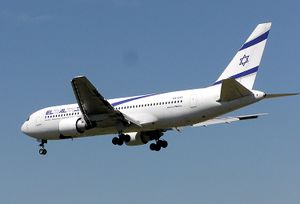
- (as of 2005)
- Hull-loss Accidents: 6 with a total of 568 fatalities
- Other occurrences: 2 with a total of 0 fatalities
- Hijackings: 5 with a total of 282 fatalities
- Two Boeing 767 aircraft were involved in the September 11, 2001 attacks, and both crashed into the two towers of the World Trade Center.
- American Airlines Flight 11, a 767-223ER, crashed into the north tower, with 92 fatalities on board.
- United Airlines Flight 175, a 767-222, crashed into the south tower, with the loss of all 65 on board. In addition, 2602 people perished on the ground, mostly in the two towers.
- Ethiopian Airlines Flight 961: On November 23, 1996, Ethiopian Airlines flight 961 was hijacked, ran out of fuel, and crashed in the Indian Ocean near Comoros. The pilots used the aircraft's ram air turbine as an emergency power source. Of the 175 aboard, 123 died. Still, the incident is one of the few instances a plane landing on water with survivors.
- Lauda Air Flight 004: On May 26, 1991, Lauda Air flight 004 crashed following the in-flight deployment of the left engine reverser. None of the 223 aboard survived.
- Gimli Glider: On July 23, 1983, Air Canada flight 143 ran out of fuel in flight and had to glide to an emergency landing. The pilots used the aircraft's ram air turbine to power the aircraft's hydraulic systems for control. There were zero fatalities. As of Feb-2007, the aircraft (C-GAUN) is still flying with Air Canada.
- In 2000, the government of China purchased a 767-300ER as the official executive aircraft of former President Jiang Zemin. The aircraft had originally been delivered to Delta Air Lines in June 2000 but was immediately resold to China United Airlines. After its transfer to the Chinese government, the plane was taken to San Antonio, Texas to be refitted with a custom interior. In the fall of 2001, the Chinese government announced that it had discovered 27 covert listening devices embedded in the plane's interior. The Chinese government blamed the CIA for planting the bugs. The 22 Chinese military and government officials charged with overseeing the refit were arrested for suspicion of negligence and corruption. The CIA and American President George W. Bush denied having any knowledge of the existence of the listening devices. Diplomatic experts worried that the incident would have deleterious effects on Sino-American relations and Boeing's reputation in the lucrative Chinese market. However, relations between the two countries remained cordial and Chinese airlines continued to purchase Boeing aircraft. The aircraft involved, however, was never put into use by the State. It was converted back to the standard layout and transferred to Air China for normal passenger service.
Trivia
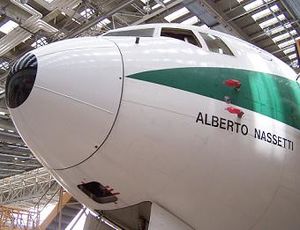
- The B-767 became the first aircraft certificated (type design approval) for CAT IIIb by the U.S. The initial U.S. CAT IIIb criteria were issued in March 1984 (AC 120-28C). This revision permitted operations with minimums as low as RVR 300.[6]
- Delta Air Lines is the world's largest 767 operator, with approximately 102 planes, including the 767-300, 767-300ER, and 767-400ER.
- Out of all airports in the world, Hartsfield-Jackson Atlanta International Airport has the highest number of Boeing 767 operations. Hartsfield-Jackson is home of the largest operator of the Boeing 767, Delta Air Lines.
References
- ↑ Boeing (2000-07-26). The Newest Boeing 767 Is Inspired by the Future. Boeing. Retrieved on 2006-08-06.
- ↑ Flight International, 3-9 October 2006
- ↑ Boeing new release: Boeing Airborne Surveillance Testbed Tracks Missiles With New Seeker
- ↑ "Boeing Unveils Air Force Tanker in $40 Billion Contract Competition." Borak, D. Associated Press. February 12, 2007.
- ↑ "Boeing Offers KC-767 Advanced Tanker to U.S. Air Force", Boeing press release, 2007-02-12
- ↑ FAA Air Transportation Operations Inspector's Handbook, Order 8400.10
External links
- Boeing 767 family page
- Boeing 767-200 page on Airliners.net
- Boeing 767 page on Janes.com
- The Spirit of Delta, Delta Airlines' first 767
- Boeing 767 photos
Related content
Related development
Comparable aircraft
Related lists
See also
Boeing airliners | |
|---|---|
| Piston-engined | |
| Jet-engined | |
| In development | |
| Proposed | |
| Not developed | 2707 · 7J7 · NLA · Sonic Cruiser |
Lists relating to aviation | |
|---|---|
| General | Timeline of aviation · Aircraft · Aircraft manufacturers · Aircraft engines · Aircraft engine manufacturers · Airports · Airlines |
| Military | Air forces · Aircraft weapons · Missiles · Unmanned aerial vehicles (UAVs) · Experimental aircraft |
| Notable incidents and accidents | Military aviation · Airliners · General aviation · Famous aviation-related deaths |
| Records | Flight airspeed record · Flight distance record · Flight altitude record · Flight endurance record · Most produced aircraft |
bs:Boeing 767 da:Boeing 767 de:Boeing 767 et:Boeing 767 es:Boeing 767 fa:بوئینگ ۷۶۷ fr:Boeing 767 gl:Boeing 767 ko:보잉 767 id:Boeing 767 it:Boeing 767 he:בואינג 767 ms:Boeing 767 nl:Boeing 767 ja:ボーイング767 no:Boeing 767 pl:Boeing 767 pt:Boeing 767 ru:Боинг-767 simple:Boeing 767 sk:Boeing 767 sr:Боинг 767 fi:Boeing 767 sv:Boeing 767 vi:Boeing 767 zh:波音767
